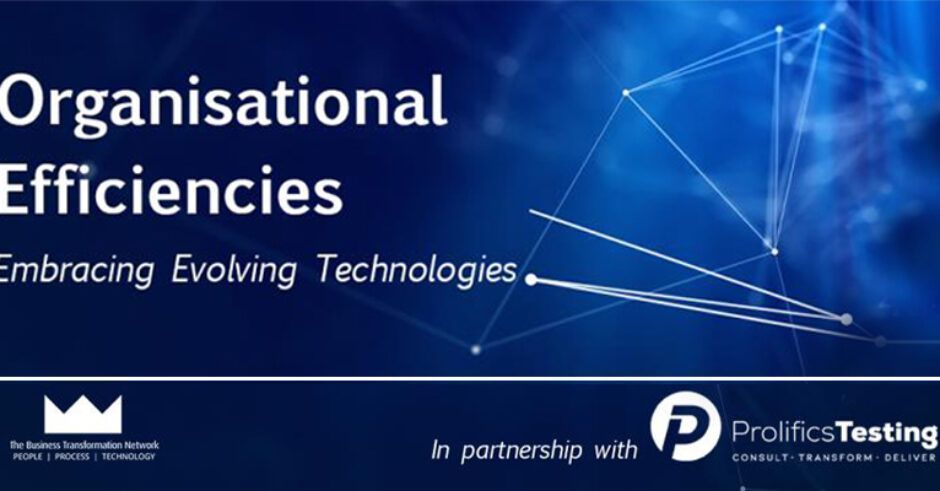We recently hosted a virtual roundtable in partnership with Prolifics Testing on ‘Organisational Efficiencies – Embracing Evolving Technologies’ which looked at future of testing in a world of Agile, DevOps and Test Automation.
The conversation was insightful and engaging with a variety of opinions and experiences from our attendees covering some key themes around the journey of test automation within organisations and the opportunities of embracing evolving technology to benefit your organisational efficiency and much more.
Over the past few years, we have seen a massive shift in organisations, with many moving to an Agile or DevOps way of working, which has led organisations to be working much more efficiently and effectively. Therefore, with organisations deploying at an ever-increasing velocity, how do the rest keep up and what would be the best practices for doing so?
The key takeaways from the conversation appear below.
Know your value case
It may seem obvious, but the point at which you are starting is integral. If you are already in a strong position, then it is easy to begin your journey into test automation, however, the less groundwork you have at the start, the harder it is to even get to a level where you would be able to begin. Our attendees varied from some with highly advanced test automation practices to some with none, which drove the conversation to look at the how, as much as anything else.
One of the biggest problems to start with is developing a ‘values case’ for the business to drive investment. It was agreed that the best way to do this was by looking at how quick the business can react to changes compared to their competitors that are working in an Agile or DevOps manner. If your competitors are reacting and adapting quicker than you are, chances are that you will, in time, lose out. It was emphasised that driving the business value case should be relatively straight forward as there are two key points to accentuate:
- What does it mean to your business to be able to do it?
- What does it mean if you can’t do it but your competitor can?
Complexity is the enemy
Ideally, organisations want the shortest test cycles to allow them to get to market quicker, ensuring that they remain competitive, but to make processes efficient and fast, they need to be simple. It was noted that although pushing for quicker test times was important, it has to be fast and safe, not just fast. Attendees agreed that although organisations need a reduction in the time corrective action takes, it needs to be done without compromising the quality or security of the offering. Complexity is one of the biggest problems faced in this process because without simplifying, you are streamlining, what is essentially, a mess. You have to break it down into incremental pieces and assess what can be changed and made leaner by working in an agile manner and what then from there can be removed, or automated. Without logic and simplification, there is a high potential that you will be automating something that still requires human intervention, in the form of corrective action, at various stages.
Everything is connected
To reach the nirvana of embracing technology and test automation you need to not only undergo digital transformation but also people and process transformation. One without the other becomes entirely redundant. Organisations not only need to adapt their processes and technology but also their mindset, which isn’t easy. The procedure of preparing your organisation for automation and to embrace the technology of the future can be a long and drawn out one, as you have to challenge your people and their mindsets. People are naturally resistant to change and this isn’t only a problem within the wider organisation, but within the IT and technology teams too, who can be change adverse as they are consistently ‘running to stand still’. An interesting point which was tackled here was the role that COVID-19 and the instantaneous need for remote working setups and the associated technology have played in rapidly dismantling people’s resistance to change.
The data is key
When it comes to automation, machine learning and AI are often the main focus points. In modern business, it seems that AI specifically is operating at a level where it is augmented intelligence until manual intervention is required, so it’s technology with human assistance. With this in mind, our attendees began to consider what you can do to bring technology like AI to the self-aware and self-learning technology you need to really make a difference to your organisation, which included a multitude of aspects, specifically the importance of the data used in this technology.
Although the technology we are working with is more advanced and has much higher potential, without the right inputs, the output will be useless. To ensure that we are using everything to the best of our ability as well as the ability of the technology itself, we need to focus on the data we are putting in. To get the benefits you expect from AI, machine learning and automation, you need to not only feed it the right data but also ensure that the context of the data to the world in which it is being applied is also correct. With this in mind, AI, machine learning and automation need a level of continuous improvement and re-training to ensure the information it is being fed (in the form of data and context) are up-to-date. We need to be mindful that AI and automation are only as good as the data we put in it and there is still a level of human interaction and support needed for automation.
It was clear that without some form of automation, there is no way an organisation will be able to keep up with the market, and their competitors, whilst also maintaining their offering to be high quality and safe. Taking the above into account, it was agreed that although the benefits are clear, sometimes it is a lot harder to get started on the process then you may initially think, which could be a result of how complex your processes and existing systems are. Complexity is the enemy, and by simplifying a process and ensuring you are providing clean and correct data, test automation and the ability to embrace technological advancements is much easier. Furthermore, although the technology is important, if you don’t transform your people and processes to match the technology and take them on that journey, the changes will never stick. You need to have a collective transformation across people, process and technology to allow your organisation to progress and become technologically advanced.

Prolifics Testing is a specialist IT consultancy with a total focus in software testing – automation, performance, consultancy and training. They deliver high quality, flexible software QA and testing services, outsourced testing on-demand, supporting their clients with digital transformation, business as usual and specialist testing disciplines. They’re part of the Prolifics group.



